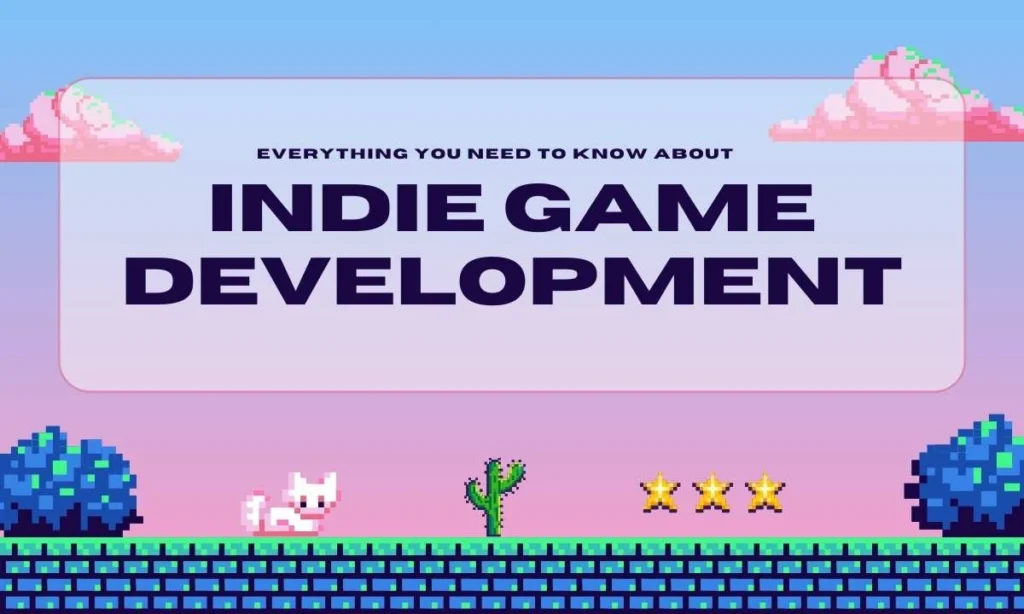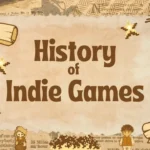Indie game development is like the wild west of the gaming world—exciting, full of risks, but also packed with creativity. Unlike big AAA games made by huge companies with hundreds of employees, indie games are often created by small teams or even a single person! The cool thing about indie games is that developers have the freedom to make the kinds of games they’ve always dreamed of, without worrying about what big companies want them to do. Games like Minecraft and Undertale started small but became some of the biggest names in gaming. In this guide, I’ll take you through what makes indie games so special, the challenges developers face, and what the future holds for these incredible games. As someone who’s been following indie games for years, I’ll also share a few tips and advice for anyone looking to dive into this world, whether as a player or developer.
What Defines an Indie Game?
An indie game is developed by small teams or individuals without major publisher support, which allows for greater creative freedom. Unlike AAA games (which have big budgets and large teams), indie games typically focus on unique ideas, taking risks that bigger studios avoid. Developers might self-fund their projects or rely on crowdfunding platforms like Kickstarter. Indie games often explore creative, unconventional mechanics, art styles, or storytelling approaches that appeal to niche audiences. Games like Hollow Knight and Celeste are great examples of how indie titles focus more on artistic expression and less on mass-market appeal.
History of Indie Games
Indie games have been around since the early days of gaming, but it was the rise of digital distribution platforms like Steam in the 2000s that really boosted their presence. In the past, indie developers had to rely on physical copies sold at local stores, which made it hard to gain attention. But with platforms like Steam Direct, developers could easily upload their games for a small fee and reach a global audience. Iconic titles such as Super Meat Boy and Braid paved the way for indie games, showing that even small, low-budget games could be critically acclaimed and commercially successful
Why Choose Indie Game Development?
Indie game development appeals to many creators because of the freedom it offers. Developers can work on projects they’re passionate about without the pressure of investors or publishers. This means more room for innovation and experimenting with new gameplay ideas that might not fit in traditional AAA game structures. Another advantage is the lower barrier to entry—with free tools like Godot and affordable options like Unity, almost anyone can start creating their own games. However, indie development also comes with challenges, like finding funding and gaining visibility in a crowded market
Popular Indie Game Genres
Indie games span a wide variety of genres, but some are more popular and frequently seen in the indie scene:
- Platformers: These games, like Celeste and Hollow Knight, focus on navigating challenging levels by jumping and solving puzzles.
- Roguelikes: Known for their replayability and procedural generation, roguelikes like Hades and Slay the Spire challenge players with unique runs every time they play.
- Puzzle Games: Indie puzzle games like The Witness often emphasize logic, creativity, and exploration.
- Narrative-driven Adventures: Games like Night in the Woods focus on deep stories and character development.
Indie Games vs AAA Games
There are several key differences between indie games and AAA titles:
- Budget: Indie games are typically made with smaller budgets, while AAA games can cost millions to develop.
- Development Team Size: Indie games are usually developed by small teams or even individuals, whereas AAA games have hundreds of developers working on various aspects of the game.
- Creative Freedom: Indie developers have more freedom to take risks and experiment with gameplay, while AAA studios often stick to proven formulas to ensure profitability.
You might like: Top Indie Game Development Studios to Keep an Eye On
Challenges in Indie Game Development
Indie game developers face several challenges:
- Funding: Without big publishers, indie developers often need to rely on personal savings, crowdfunding, or small publishers for financial support.
- Marketing: Standing out in a crowded marketplace can be tough, especially when AAA games dominate attention.
- Technical Hurdles: Indie developers might not have access to the latest technology or development resources, making it harder to create games that compete with larger studios.
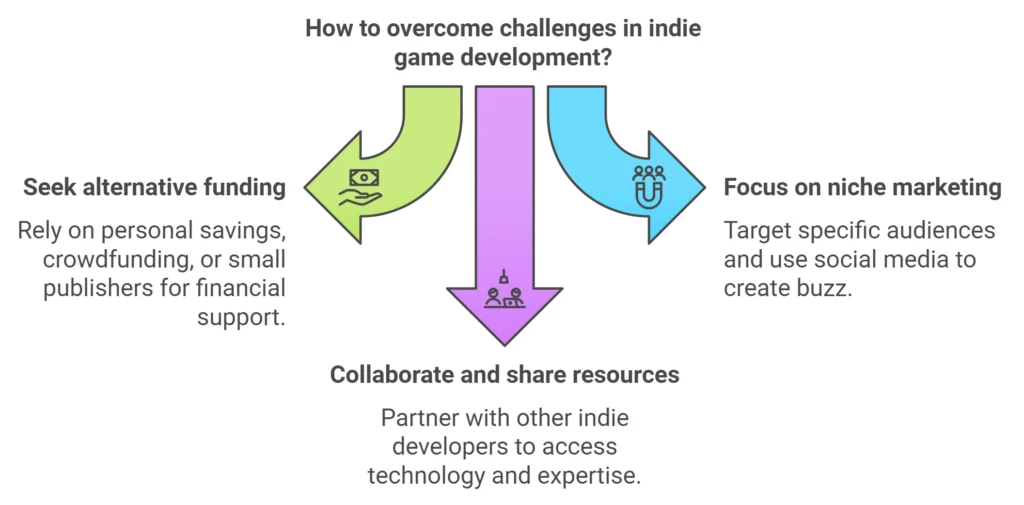
Tools for Indie Game Developers
Indie game development requires a variety of tools to turn ideas into reality. Here are some of the essential game engines used by both beginners and experienced developers:
- Game Engines:
- Unity and Unreal Engine are popular choices for 3D games. Both offer robust features, with Unity excelling in ease of use and scalability, while Unreal is known for its advanced graphics capabilities.
- For 2D games, GameMaker Studio and Godot are excellent options. GameMaker Studio is great for rapid prototyping and is easy for non-coders, while Godot is open-source and versatile.
- Art & Animation Tools:
- Blender is a free, open-source tool for creating 3D models and animations, making it ideal for indie developers on a budget.
- Aseprite is perfect for creating pixel art and animations for retro-style games.
- Sound Design:
- FMOD is a powerful tool for adding dynamic, interactive soundscapes to games, and it’s free for smaller indie projects.
These tools offer affordable solutions for indie developers to create professional-quality games.
Indie Game Development Trends
Indie game development is always evolving, and several trends are shaping the current indie games landscape:
- Pixel Art & Retro Games: Games with a nostalgic feel, like Undertale and Celeste, continue to thrive, offering both simplicity and emotional depth.
- Roguelikes: Games like Hades have popularized this genre, where players experience procedurally generated challenges in every playthrough.
- Narrative-Driven Games: Titles like Night in the Woods show the power of indie games to tell deeply personal and thought-provoking stories.
These trends highlight how indie developers can focus on unique ideas and styles that are often overlooked by larger studios.
The Role of Innovation in Indie Games
Innovation is at the heart of many successful indie games. Without the constraints of large publishers, indie developers are free to experiment with mechanics, storytelling, and art styles. For instance:
- Game Mechanics: Many indie games, like The Witness and Slay the Spire, introduce fresh gameplay ideas, combining genres or creating entirely new ones.
- Storytelling: Indie games often push narrative boundaries, exploring themes like mental health and existential crises in ways AAA games rarely do, as seen in Celeste and Night in the Woods.
Innovation helps indie games stand out in a crowded market, offering players experiences they can’t find anywhere else.
Networking for Indie Game Developers
Networking is crucial in the indie game development scene. It helps developers find support, collaborators, and feedback throughout the development process. Here’s how indie developers can build strong networks:
- Online Communities: Forums like TIGSource and platforms like Game Jams are great places to connect with other developers, share ideas, and get advice.
- Social Media: Engaging with communities on Twitter, Reddit, and Discord can help developers gain visibility and attract fans early in development.
- Industry Events: Conferences like GDC (Game Developers Conference) and local meetups provide opportunities for indie developers to network with industry professionals, publishers, and potential collaborators.
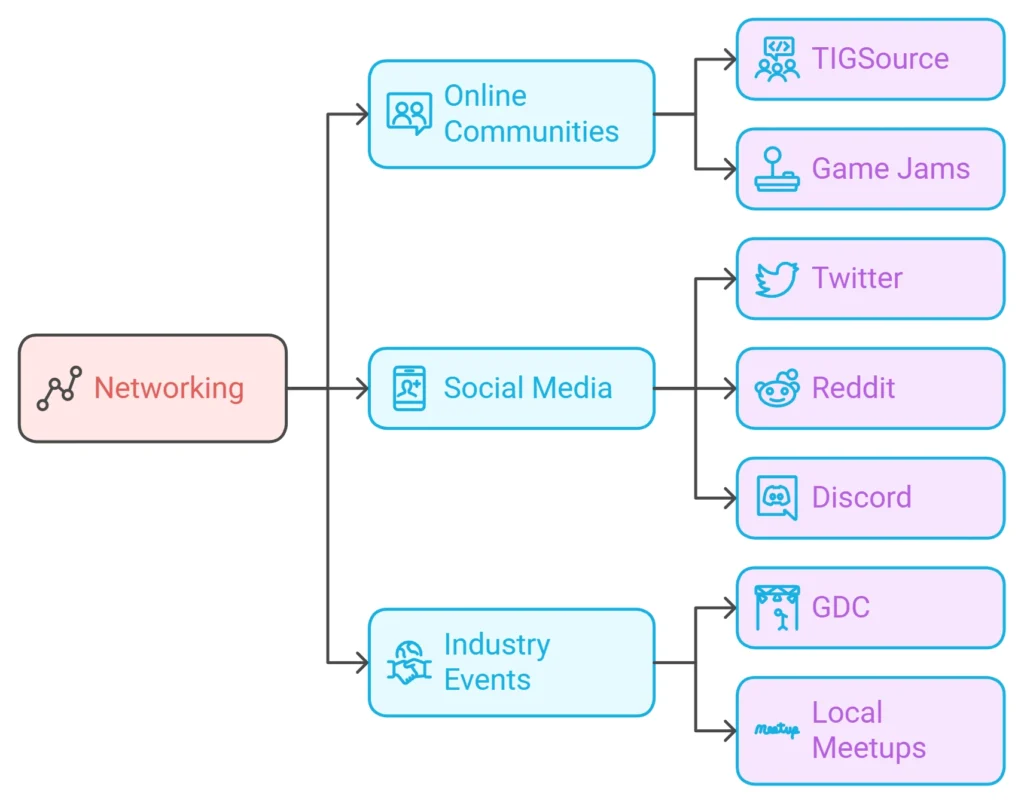
These connections are often the key to successful collaborations, funding opportunities, and marketing.
How Indie Games Impact the Industry
Indie games have reshaped the gaming industry in several ways:
- Innovation: Indie developers often push the boundaries of gameplay, mechanics, and storytelling. Games like Hades and Undertale have shown how experimental design can lead to massive success.
- Cultural Influence: Indie games tackle important social and cultural themes that AAA games may shy away from. For example, Celeste addresses mental health struggles through its gameplay.
- Business Models: Indie games have popularized new models like crowdfunding (through platforms like Kickstarter) and “pay-what-you-want” pricing on Itch.io, providing more flexibility for both developers and players.
Indie games continue to challenge the dominance of big studios by focusing on creativity and community-driven support.
Why Passion Drives Indie Games
Passion is at the core of indie game development. Unlike AAA developers who are often driven by financial goals or publisher demands, indie developers are fueled by their personal vision and creative ambitions. This allows them to take risks, experiment with unique mechanics, and focus on artistic expression rather than market trends.
Developers like Eric Barone, creator of Stardew Valley, spent years working solo on their game, driven purely by the desire to create something personal and meaningful. Similarly, the brothers behind Cuphead were passionate about bringing their vision of 1930s cartoon-style animation to life, despite the many challenges.
This passion often results in indie games that connect deeply with players, offering experiences that larger studios might avoid due to financial risk.
Cost of Indie Game Development
The cost of developing an indie game varies widely based on several factors, including team size, game complexity, and resources. On average, indie games can cost between $50,000 and $750,000. For smaller projects, especially those with 1-2 developers, the cost might be as low as $5,000, covering software licenses, hardware, and essential development tools. However, larger projects with more polished graphics and gameplay can exceed $1 million.
Key cost areas include:
- Development tools and software: Many indie developers use affordable or free game engines like Unity or Godot.
- Art and audio: Custom art, animation, and music can increase costs, especially if outsourced.
- Marketing: Promotional efforts can take up 10-20% of the total budget
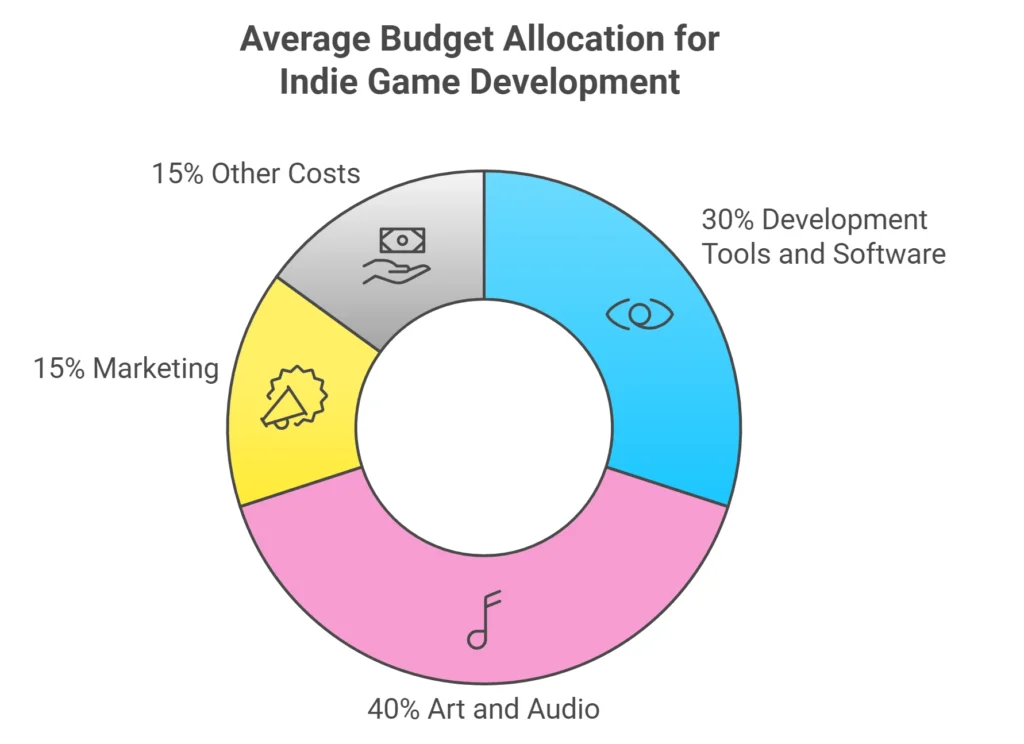
Proper budgeting and planning are essential to managing these costs and ensuring that hidden expenses, like localization or platform fees, don’t derail the project.
Game Engines for Beginners in Indie Games
Choosing the right game engine is crucial for indie developers, especially those new to the field. Here are some beginner-friendly options:
- Unity: One of the most popular engines for both 2D and 3D games. It’s accessible to beginners, offering a large library of tutorials and community support. Unity’s flexibility allows developers to create games for multiple platforms, including PC, consoles, and mobile.
- Godot: An open-source engine known for its user-friendly interface and small footprint. Godot is great for 2D games but can handle 3D projects as well. It’s particularly loved by indie developers for its zero cost and supportive community.
- GameMaker Studio: This engine is ideal for 2D games and provides a drag-and-drop interface, making it a solid choice for developers with no programming experience. Many successful indie games, like Undertale, were created with GameMaker.
Each of these engines has its strengths, and the choice depends on the developer’s needs and the type of game they want to create.
Indie Game Development Communities
Connecting with other indie developers is crucial for learning, collaboration, and feedback. Several online communities serve as hubs where indie devs can share ideas, get advice, and find potential collaborators. Here are some of the top places to engage with fellow developers:
- Reddit (r/gamedev): One of the most active communities with over 300K members. It’s a go-to space for developers to ask questions, get feedback, and showcase projects.
- Develteam: This platform allows developers to share portfolios, find collaborators, and browse a collection of game tools and assets. It also provides forums and chat rooms for project-specific discussions.
- Discord (Game Dev League): Discord is popular for its real-time chat format. The Game Dev League server offers multiple channels where developers can showcase work, seek advice, and connect with like-minded creators
These communities not only provide resources but also foster valuable relationships that can help you stay motivated and navigate the challenges of game development.
The Role of Feedback in Indie Game Development
Feedback is a critical part of the indie game development process. Developers often rely on community input to refine and improve their games before release. Here are some key ways feedback shapes indie game development:
- Early Access & Beta Testing: Many indie developers release early versions of their games to gather player feedback. Platforms like Steam Early Access and Itch.io allow developers to continuously update their games based on user input.
- Player Feedback: Indie developers often build strong connections with their communities, responding to comments on forums, social media, and platforms like Game Jolt. This helps them identify bugs, refine mechanics, and gauge audience expectations.
- Iterative Development: With each round of feedback, developers can make adjustments, ensuring that the final product meets player expectations and is polished.
How to Stay Motivated as an Indie Developer
Staying motivated during the long development process of an indie game can be tough. Here are some strategies to help you maintain focus and energy:
- Break the Process into Milestones: Setting smaller, achievable goals can help avoid burnout and keep you motivated as you check off each accomplishment.
- Participate in Game Jams: Short, time-limited game development competitions can spark creativity and provide quick wins to keep your motivation high.
- Connect with the Community: Engaging with other developers in forums like Develteam or on Discord not only provides support but can also inspire you through collaboration and shared successes.
- Celebrate Progress: Don’t forget to celebrate your accomplishments, even small ones, to keep the excitement alive throughout the process.
Future of Indie Game Development
The future of indie game development looks exciting and full of opportunities as new game trends and technologies emerge. Here are some key developments to expect in 2024 and beyond:
- Cross-Platform Play: More indie games will be designed to work seamlessly across platforms like PC, consoles, and mobile devices. This broadens the reach of indie games, making them more accessible to a wider audience.
- Advancements in AR/VR: With the decreasing cost of AR/VR hardware, indie developers are in a great position to experiment with these technologies. This opens up new possibilities for immersive gameplay and creative storytelling.
- Subscription Models: Services like Xbox Game Pass and PlayStation Plus offer indie games more visibility. Subscription-based gaming is becoming more popular, providing a stable source of income for developers, as well as broader exposure.
- AI Integration: The use of AI in game development continues to grow. AI can now help create dynamic storylines, optimize game performance, and adapt gameplay to players’ preferences, allowing indie developers to offer highly personalized gaming experiences.
Overall, the future for indie games is bright, with technology enabling more creative freedom and the potential to reach larger audiences.
Conclusion
Indie games are changing the gaming world because they allow developers to get super creative and break all the rules. With new tools like Unity and Godot making it easier to create games, and with platforms like Steam helping these games reach players, indie developers have more opportunities than ever before. Plus, technologies like virtual reality (VR) and artificial intelligence (AI) are giving indie games new ways to stand out and offer experiences that AAA games just can’t match. From my experience, the most important advice I can give to anyone interested in indie games—whether you want to make them or just play them—is to never stop experimenting. Indie developers succeed by doing something different, something new. So, if you have a game idea, don’t worry if it seems a little strange—go for it!

